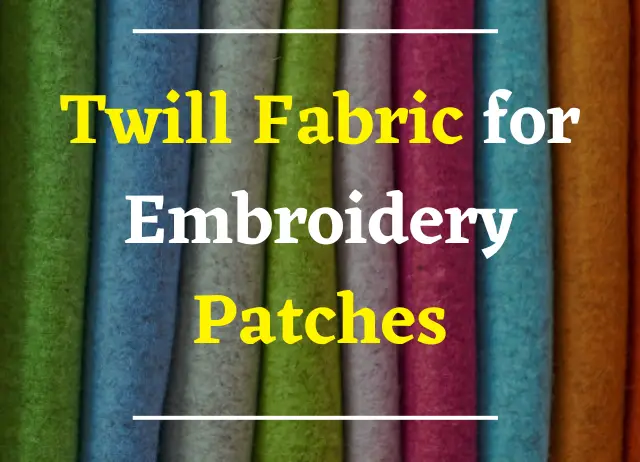
If you’re into making custom embroidery patches, twill fabric is a perfect base material. This post will share everything about Twill from years of experience so that you feel confident using it to create an embroidery patch.
What is Twill Fabric?
Twill is a woven fabric known for its subtle diagonal ridged pattern. This pattern gives twill some unique properties that make it work very well for patches. The tight weave makes twill fabric for patches quite sturdy and stable during the embroidery process. It won’t bunch up or warp like some other fabrics.
Twill also comes in many solid colors, which is great for matching designs. It can be found in just about any hue. The diagonal twill pattern helps the fabric retain its shape nicely too. Even after being folded up for a long time, patches will still look fresh.
Choosing the Right Twill Fiber for Your Custom Patch
The fiber it’s made from is an important choice when it comes to twill fabric. Let’s take a closer look at the three most common fibers used: polyester, cotton, and nylon.
Types of Twill Fibers
Polyester Twill
Polyester twill is very durable and hard-wearing. It won’t shrink or fade over time with washing. This makes it a great option if your patch will see lots of wear and washing. Polyester twill also comes in a huge range of colors to choose from.
- Extremely durable and hardwearing
- Won’t shrink or fade with washing
- Huge color range available
- Inexpensive
- Less breathable than natural fibers
- Can feel stiff compared to cotton
Cotton Twill
For a softer, more flexible twill, a cotton is a nice option. The texture of cotton twill feels nice against the skin. It’s a good choice if hand-feel matters to you.
- Soft and flexible texture
- Breathable
- Lots of color dyes work well with cotton
- Not as durable or wash-fast as polyester
- May shrink more over time
- More expensive than polyester
Nylon Twill
Nylon twill is tough to beat if you need ultimate strength and abrasion resistance. It’s hydrophobic, so moisture won’t cause issues. Great for patches that may see rough outdoor use.
- Extremely strong and abrasion-resistant
- Hydrophobic and mildew-resistant
- Breathable high-performance fiber
- Can be stiff compared to cotton or poly
- More expensive than polyester
How To Identify Twill Weave Types
Plain Twill: Plain twill has consistent, parallel ridges from one thread regularly floating above and then under. It is great for large logos or text.
Basket Twill: Basket twill builds on plain twill with a “skipped” effect, making ridges vary in thickness and direction adding subtle depth.
Herringbone Twill: Herringbone twill features distinctive V-shaped ridges like a herringbone pattern. It is perfect for accenting a standout design element.
Stabilization Methods
Using the right stabilizer is key to getting great results when working with twill fabric for your embroidery patches. Stabilizers help prevent puckering and give your stitches definition.
Cutaway Stabilizer: Cutaway is cut around your design and provides support without bulk.
Tearaway Stabilizer: Tearaway is soluble and disintegrates, allowing you to remove it easily after stitching.
Water Soluble Stabilizer: They dissolve completely after washing so your patch feels great.
Heat Away Stabilizer: Heat away stabilizer is another choice – it simply melts away with steam.
Techniques for Working with Twill Fabric
Hooping Twill
Twill can be tricky to hoop smoothly without wrinkles. Here are some tips to keep it taut:
- Use two hoops – An outer hoop helps hold larger pieces flat.
- Spray adhesive – Apply a light coat of temporary adhesive to adhere twill.
- Cut slits – Make airflow slits in twill corners to release trapped air.
- Insert stabilizer – Adding a stabilizer pulls excess fabric to the hoop backing.
With some practice, you’ll be pro at getting twill perfectly hooped for top-quality embroidery results. Best of all, these techniques work for any woven material.
Finishing the Edges
To prevent unraveling, use either overcasting or fray check on raw cut edges. Overcasting involves a zigzag stitch along the edge while fray check is a liquid that seals cut fibers when dry.
Mounting Embroidered Patches
You can attach patches using sewing, iron-on adhesive, or Velcro backing. Sewn patches are traditional, while iron-on adhesive securely bonds patches, making them an efficient choice for many applications. If you’re looking for guidance on using iron-on techniques, explore our tips on Iron-On Patches on Polyester to ensure a seamless application.
Best For Heavy Use
Twill fabric is the best material for creating custom patches for workwear, sportswear, branding businesses, and more. The diagonal twill weave keeps it from wrinkling and makes it sturdy. Using the tips above makes the best quality twill custom patches for uniforms, logos, or whatever your design is. They can be washed or worn a lot before looking old. No matter what you need patches for, twill fabric can be used to create custom patches that stay looking good through heavy use.
